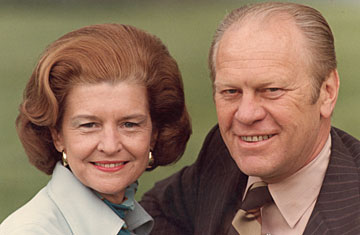
Betty Ford and her husband, President Gerald Ford, are shown in a 1976 photo. The former First Lady, who brought her struggles with alcoholism and breast cancer into the public spotlight, died July 8, 2011, at 93
Honesty in marriage, like in politics, can be a gift or a weapon. Betty Ford's husband Jerry loved her fizzy candor, her firm commitment when she believed in something and her refusal to pretend when she didn't. She wore a mood ring, but that was redundant; she wasn't one to hide an attitude anyway, any more than she'd hide how much her psychiatrist had helped her or what she thought of her children's sex lives or which of her breasts was removed by doctors when she got cancer. So as the U.S. wrestled with the role it wanted women to play, she marched with Betty Friedan in support of the Equal Rights Amendment. As the political stars realigned for a generation around Roe, she called the court's abortion ruling "a great, great decision." As the trauma of Vietnam lingered, she discussed amnesty for draft dodgers. When after seven weeks in office she discovered the cancer, she bared her pain in public. She was unlike any other First Lady and yet perfectly suited to her time — 29 months in the White House, during which America was catching its breath and checking its pulse to see if basic institutions and assumptions could survive the shock of the Nixon presidency. Her long combat against addiction brought all kinds of suffering out of the shadows. When she died Friday, July 8, at the age of 93, America lost one of its most unlikely and unmatched healers.
Transparency is not the normal First Lady format: life in the White House means trying to keep your sanity, keep your husband grounded and keep out of trouble. This is always easier to manage as a porcelain figurine propped at the President's side than as a living, breathing, conspicuously imperfect and opinionated partner with weaknesses she didn't try to hide. Betty Ford was by no means the first strong and influential First Lady, but she was the first to take her personal power public in ways that changed the role and the country at the same time.
As a child growing up in Grand Rapids, Mich., Betty Bloomer met a fortune teller who read the tea leaves and told her that one day she'd meet kings and queens. If that image lodged anywhere in her daydreams, she would do so as a great dancer, for that was her passion. She began dance lessons when she was 8 years old and was serious enough to pass up a college degree, heading instead to New York City to join Martha Graham's auxiliary dance group. This represented a full-immersion course in rule breaking and graceful defiance; the fierce, barefoot priestess of modern dance, Graham was both a revolutionary and "a great disciplinarian," Ford said, "and that has given me the strength to carry on. Had I not had that association with her, I might not have been able to do as well."
That strength was useful when she moved back to Grand Rapids in 1941 and married a local furniture dealer named William Warren. The marriage didn't take — she called it "a five-year misunderstanding" — but as they prepared to go their separate ways, he fell suddenly into a diabetic coma, and she spent the next two years nursing him back to health before they divorced.
At 29, she fell in love with a hometown hero, a former college-football star and rising young lawyer who failed to mention until after she agreed to marry him that he was running for Congress. Gerald Ford was elected to the House two weeks after their wedding in October 1948, and together they began their long, unplanned and unlikely journey to the White House.
